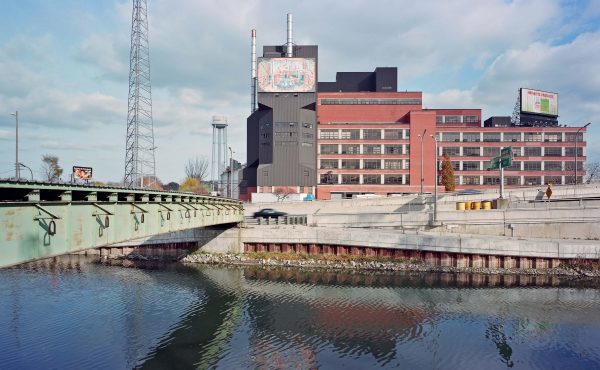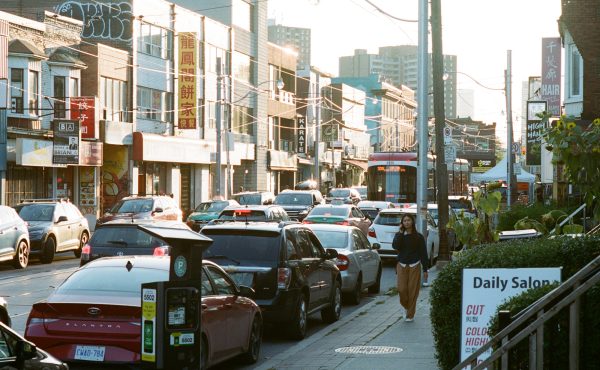Mexico City is a huge megalopolis of 20 million people, all crowded into a plateau surrounded by volcanic mountains. In many ways, Mexico has the same messy urbanism that defines Toronto. In an earlier post, James Rojas remarked how in Toronto, “rickety and ramshackle Victorian buildings sit snugly next to sleek modern 20-story condos. Tree-lined streets of row houses (some restored, many not) run right into bustling commercial boulevards filled with streetcars, bicyclists, traffic, produce vendors.” Mexico City isn’t Toronto, but it has many similar characteristics, with a mix of colonial-era and art deco treasures cheek-jowl to buildings from the 1950s and 1960s that look almost ready to tumble, to grand modernist and interesting post-modern skyscrapers all in the downtown core.
I had the chance to visit Mexico City on a three-day stopover on my way home from an international conference related to my work a few weeks ago in Merida, Mexico. I originally had plans to meet with local people I knew, but after those plans fell through I made my way around and got to explore on my own. Despite a reputation for crime, I found the city to be as safe as any other, provided one uses basic common sense. The high altitude (over 2 kilometres above sea level) and heavy pollution had their effect, but one gets used to it.
La Paso Reforma is very much the epitime of a grand boulevard, and is worthy of a European capital. The route is lined with statues and monuments to historical persons and dates in the country’s history and with lots of trees providing shade and visual contrast to the built environment. This route, linking the old City Centre with Chapultepec Park, reminded me of a greener, grander University Avenue, but with the same sterility – the land uses are mostly institutional and office commercial.
Yet off the main avenues, the architecture and streetscape changes quickly. The greatest contrast to Paseo de la Reforma were the old market streets surrounding the Zà³calo, which are anything but sterile, but bustling with activity. The Zà³calo, the famous central square, and one of the biggest in the world, is surrounded by historic monuments – the Metropolitan Cathedral, the Presidential Palace, the ruins of the old Aztec city. Taking a bus out to Teotihuacà¡n, I passed by middle class suburbs, shantytowns, and a greenbelt of sorts. It’s an amazing contrast to the typical European or North American cities that I have visited before.
 The Zocalo from the Torre LatinoAmerica
The Zocalo from the Torre LatinoAmerica
 The market area east of the Zocalo
The market area east of the Zocalo
I found a few things that might be of interest of regular Spacing Wire readers. The first is the creative streetscaping along Reforma. Surrounding El àngel (the most famous monument in the city) are benches, each of a different creative design. It’s a little thing that I thought was rather clever and easily done here.


One other thing that I found interesting was the new Metrobàºs system installed on Avenida Insurgentes, a main north-south street. It was built to address a gap in Mexico City’s 11-line Metro network and to reduce congestion, largely caused by the multitude of semi-formal minibuses (which can be described as fixed-route jitnes) that used to provide public transportation on that street. The bus rapid transit system is similar to that in Curitiba, Brazil – inexpensive stations are built in the centre median, with fare payment done upon entry to the stations. Buses have high platform doors on the left side, so only one fare-paid area is required per stop. Like the Metro, each stop has a unique icon to identify it, a system originally intended to assist illiterate passengers, and somewhat similar to Paul Arthur’s TTC signage experiment. Short concrete blocks, like those found in parking lots, separate bus-only lanes from general traffic. Buses were packed solid. There are plans to add more BRT routes like that on Insurgentes, as well as a new subway line across the south of the city.
 Metrobuses on Avenida Insurgentes at the Reforma stop.
Metrobuses on Avenida Insurgentes at the Reforma stop.
 Inside a Metrobus stop.
Inside a Metrobus stop.







7 comments
Great comparison! I live in Mexico City and found this little article very interesting. Mexico City still has pending numerous issues regarding its urban trace. I was once in Toronto and found it a wonderful city, where people have a great sense of urban education, at least compared with mexican standards. You wouldn’t ever implement a paying method like the one of VIVA in Mexico. Never. People just wouldn’t pay, and it would be easier to bribe a cop if you get caught! Another remarkable difference is that in Mexico City you will find a myriad of potholes everywhere, except for Paseo de La Reforma, where the great wealth is found and nobody lives obviusly. Else it’s still a great city to live in. BTW: notice the white sing in the foreground of the last picture… the words ‘Indios verdes’ are upside down!! and the clock shows 22:02!! that’s very very mexican!
Cheers
Sean, I know being male you didn’t experience the transit system from the perspective of a woman but I’ve read news stories realtively recently about some parts of Mexico City’s transit system being so unsafe for women that they’ve offered women-only buses and subway cars. What impression were you left with regarding the safety of the transit system and the city in general?
Adam,
I had many warnings from friends and others to not go out late at night, to stick to tourist and other high-traffic areas, not to eat food from street vendors, not to ride in the green-and-white mini-taxis, not to ride the minibuses, etc, etc. Not having a command of the Spanish language would make me vulnerable, as well as looking like an average “gringo”.
I felt safe, though my travels did not take me far from the high-traffic areas anyway, and returned to the hotel just after dusk. I picked enough Spanish to ask questions like prices and directions, greetings, and that, so I got by on my own. (Not many people know any English there.) I did ride the minibuses in Mexico City (as well as in Merida) and it’s an interesting way to travel.
You are correct that the subways have a bad reputation. All metro stations that I saw have signs towards the front of the trains saying that only women and children can board beyond that point. Only women and children could enter Metrobuses from the front doors.
It’s a tough question for me to answer, but I felt more unsafe in the marginal areas of US cities. That said, being an younger adult male sticking mostly to higher traffic areas left me without fears of anything worse than pickpocketing. I could just imagine what a single woman’s perspective might be.
Funny, one of the first things that struck me on my two visits to Mexico City was how much it reminded me of Montreal. The haphazard planning, the decaying-but-maintained look of all the infrastructure, the random art and political graffiti everywhere, etc. The metro actually even uses the same Bombardier trains as MTL’s.
Truthfully, I didn’t personally find that it reminded me of Toronto at all.
I spent some time on the Mexico City metro during rush hour and noticed a few things: a) the trains came every 45 seconds or so; b) each one was completely packed, not just in the Toronto sense, but in the literally-impossible-to-move sense; c) there was so much aggressive behaviour going on in the “men-only†cars that even I, a 6’4â€Â, 200 lb. male, was afraid to get on. (I ended up going out of my way and taking a different, less-crowded line.) That aside, however, I love the metro for its massive network, its frequent service, and its price (only $0.20 CDN a ride!). Even the minibuses are great as long as you know where you’re going. Getting anywhere in Mexico City takes forever — regardless of mode of transportation — but I find the transit network does a pretty great job under the circumstances.
Eye opening – thanks. Much more North American in terms of buildings and streetscapes than I realized.
I was just in the Bay Area on the weekend, which is so damn physically gorgeous (geography, buildings, landscaping) that it is hard to leave. For messy urbansim, downtown Berkeley is a pretty good candidate. San Fran itself is rather manicured these days – it’s not really a fair comp to dirty, rundown Toronto.
We visited Mexico City several times last year and really enjoyed it. We walked and took transit everywhere and it seemed mostly fine. My girlfriend spent more time there than I did and she rode the subway frequently on her own … we even didn’t realize there was women-only transit until later when we read that article everyone’s referring to. It’s amazing seeing the mass of people in the subway stations during rush hour. But if we took a taxi, we always took a secure cab (one trip worth taking is riding across the gigantic Periferico highway at night).
And we did experience a flash of Montreal in Mexico City. We stayed in a little hotel on Plaza Rio de Janeiro and it felt just like staying in a b&b on Square St. Louis. Except the temperature in Mexico City is mid-20s all year long.